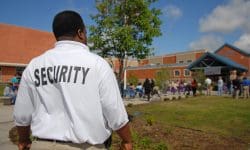What Happens When ‘The Big One’ Hits?
Upgrading your two-way radio systems as well as preparing the networks and personnel supporting your emergency communications will give you greater confidence that they will come through when disaster strikes.

Immediately after a disaster, often landline and cell phone networks are down or over crowded, leaving campus police with only their two-way radios for emergency communications.
A category 5 hurricane flattens Dade County, Fla.; a 7.8 earthquake shakes Los Angeles to its foundation; an F5 tornado ravages Fargo, N.D.; a massive ice storm paralyzes the Northeast; a terrorist attack cripples New York — these are just some of the disasters that have either already happened or are expected to occur at some point in the near future. Ask any meteorologist, seismologist or terrorism expert, and they’ll say it’s not a question of if, but when.
Knowing this and understanding that as campus first responders you and your officers will most likely be involved in the immediate aftermath, you need to be certain your emergency communications systems will be operational in these extremely challenging environments. If you wait to check the viability of your equipment and networks until a hurricane like Katrina is looming offshore, you will be too late.
If there is any lesson to be learned from last year’s hurricane season, it is that being prepared before disaster strikes is the best way to ensure your campus will be able to respond appropriately. That same level of preparedness should also apply to your emergency communications system.
Now is the time for your department to review the viability of your two-way radio equipment, talk groups, mutual aid agreements and emergency communications policies, procedures and networks.
Be Ready to Go It Alone Initially
Immediately after a disaster, you and your officers will most likely be on your own for several hours (and even days in some cases) with possibly only your two-way radios functioning for emergency communications.
Commercial cellular networks and towers, as well as landlines, may be down due to building collapse, flooding, fire or damaged infrastructure. Even if the infrastructure remains intact, the cellular networks and traditional phone networks will probably be overloaded because parents and concerned family and friends are calling the affected areas to check on loved ones. Busy signals and dropped calls are to be expected.
Because of this, two-way radio communications that are on separate, secure channels with minimal interference are critical in the hours immediately after a catastrophe. For universities, hospitals and large school districts, your officers and administrators may already be using these radios on a daily basis, but the equipment possibly needs to be upgraded for interoperability. For other, smaller institutions, the radio systems may be close to nonexistent.
Whatever the size or type of your campus, it makes sense to take a fresh look at how you’ll communicate during and after a disaster. Done on a regular and comprehensive basis, these reviews will help you make the appropriate revisions and upgrades so your two-way radio system will be ready for when you need it the most.
Involve Key Players in the Planning
When a campus begins its review, it is important to cultivate a dialogue with all of the personnel and agencies that will be using the system. “Talk to your facility manager, security professionals and others to make sure their requirements are clearly understood,” says John North, general manager of Long Beach, Calif.-based Kenwood U.S.A. “Once the system is deployed, the buy-in of all of those stakeholders means that training runs smoothly since all are invested in the success of the new system.”
North also stresses that talk groups need to be planned properly at the beginning of the procurement process, otherwise, there may be chaos during an emergency. “If personnel are in the wrong talk groups, they may get lost in the system and not get the messages being directed to them. The system can be designed to include public safety-specific talk groups or frequencies allowing communications with people within the building. It can also be designed as an interoperable solution that would enable outside users to communicate using the building’s wireless infrastructure.”
Partnerships and memorandums of understanding also need to be developed with police departments, fire departments, and other universities and hospitals in neighboring cities and counties so that when an emergency happens, the lines of communication are clear.
K-12s May Require a Point Agency
With K-12 school districts, this type of planning may need to be done on a district, city or even county level. For example, approximately two years ago, the Harris County (Texas) Department of Education’s Center for Safe and Secure Schools made arrangements so it would be the link between most of the K-12 schools in eastern Texas. This proved to be a successful strategy during the Hurricane Katrina and Rita evacuations. The center was the point agency designated by the Federal Emergency Management Agency (FEMA) to coordinate all of the education relief efforts for Texas.
Long before Katrina and Rita hit, the center approached FEMA, the Department of Homeland Security (DHS) and other local and federal agencies to develop working relationships with these entities. According to Dr. John E. Wilson, managing consultant for the center, “They told us, ‘We don’t want to have to contact each school district or school to set up arrangements because we don’t know who to contact. We would like to make one phone call to your center so you can disseminate information and coordinate our efforts with all of the school districts.’”
As a result of these plans and predefined relationships, Harris County was able to efficiently and effectively coordinate the massive evacuation of Hurricane Katrina evacuees from the Houston area as soon it was determined that Hurricane Rita was going to hit Texas.
Can Your Radios Talk With Others?
Once relationships with all of the stakeholders, both on campus and in neighboring cities and counties, are established, campus officials can begin working to resolve equipment interoperability issues. A system that is interoperable, meaning it can communicate with the systems of the local city and county police, is obviously critical.
“Plan for who you’ll need to talk to and arrange to have radios that will be compatible,” says Gregory Pascal, communications, records and information supervisor for California State University, Long Beach (CSULB). “For example, if I were on a campus that was surrounded by an area that uses a UHF system, I would think long and hard about buying VHF radios.”
CSULB’s current system works fairly well with the city of Long Beach (where the university is located), but the city may soon change to a 700MHz system. If that happens, CSULB will have a significant interoperability problem that will need to be addressed. Fortunately for campuses looking to purchase new two-way radio systems, equipment is now being manufactured that complies with the Association of Public-Safety Communications Officers’ (APCO) Project 25 (P25) interoperability standards. Unfortunately, these upgrade projects can be expensive, labor-intensive and time-consuming. As a result, many campuses haven’t upgraded their equipment yet.
According to David Manning, director of sales operations for Motorola of Schaumburg, Ill., “Some users haven’t made the individual commitment to invest in systems that are P25 compliant. There is still a gap between cities and counties in working together across their geopolitical boundaries to create interoperability plans.”
To address these issues, Motorola has released its MotoBridge, which is a gateway patch that can tie disparate systems together. The product can be used as a stopgap technology until agencies can purchase P25-compliant equipment.
A lower-tech solution to the interoperability challenge may be to simply swap radios with local agencies and designate liaisons. Mark Crosby, president of the Enterprise Wireless Alliance (EWA) says, “If you want instant connectivity to the local police and fire departments, you need to sit down with those agencies and make sure one or two of the campus’ key people have a radio or other device. If the lines go down or if there is an emergency, they can radio that police or fire department.”
This solution was used recently by CSULB when its commercial carrier’s service went offline for several hours.
A Good Frequency Is Hard to Find
Before any equipment is purchased, however, campus officials must obtain the appropriate authorizations for the spectrum, which can be extremely difficult to obtain because so many organizations need frequencies for communications. Smaller campuses, such as community colleges, may only have access to business frequencies that are very crowded.
“Depending on how close other businesses are to us, we get bleed over from them,” says Lt. Richard Bukowiecki of Cerritos College in Norwalk, Calif. “One of the great restrictions on our radio system is that we have to limit the range. Otherwise, we pick up too much outside traffic.”
In an emergency, congested spectrum is particularly problematic. Fortunately, some two-way radios have multiple levels of prioritization so a mission-critical commander who must get through can do so with the simple push of a button.
For hospitals, frequency interference with wireless devices, such as wireless heart monitors, can be a challenge unless you undertake the proper precautions. “There are techniques where radios and wireless communications don’t interfere with these things but also penetrate so you have coverage throughout the hospital,” says Crosby. “It takes a little more engineering, but the competency is in the marketplace to get these things done.”
According to Manning, “Typically, the radio spectrum that our private two-way radio systems and even our data systems operate on are private, set aside for public-safety types of operations. They don’t operate within the same frequency spectrum as a lot of hospital equipment or other spread-spectrum or other public RF environments.”
Site Studies Determine Coverage
After spectrum authorization has been obtained, coverage issues need to be addressed. This is particularly important for campuses that have recently expanded in size or constructed new buildings that may have created dead spots. Office basements, although not impossible to cover, pose other challenges.
“Complete coverage on the grounds can only be achieved by conducting comprehensive onsite path-loss studies that allow the system designer to provide the right balance of interior and exterior coverage,” says North. “A single antenna outside a building will often provide excellent exterior coverage but miss the mark inside some buildings or basements. Multiple antennas, distributed antenna systems and bidirectional amplification systems are often employed in these types of radio system designs in order to provide the needed level of coverage inside and out.”
User Training Is a Must
Even if you’ve purchased the proper P25-compliant equipment, obtained open frequencies, designed the system so it has 100-percent coverage and developed all of the necessary mutual aid agreements and talk groups, you could be in trouble if your people aren’t trained on the system.
This was a problem with Harris County during Hurricanes Katrina and Rita. “We had about 48 800MHz radios sitting in a closet waiting for us to get our training done and protocols written so we could distribute those out to our schools,” says John Bremer, project coordinator for the Harris County Department of Education’s Center for Safe and Secure Schools. “We had some out there but not as many as we needed.”
According to Bremer, if Hurricane Rita had hit only a month later, all of Harris County schools would have completed their training and the radios would have been deployed, making the county’s evacuation efforts go much more smoothly.
Harris County is continuing to work on improving its emergency communications system. Other campuses, however, are not nearly as far along in the process. Hopefully, they can catch up before an F5 tornado or terrorist attack hits their hometown.
Robin Hattersley Gray is Executive Editor of Campus Safety Magazine. She can be reached at robin.gray@bobit.com.
For the complete version of this article, please refer to the January/February 2006 issue of Campus Safety Magazine.
If you appreciated this article and want to receive more valuable industry content like this, click here to sign up for our FREE digital newsletters!
 Leading in Turbulent Times: Effective Campus Public Safety Leadership for the 21st Century
Leading in Turbulent Times: Effective Campus Public Safety Leadership for the 21st Century
This new webcast will discuss how campus public safety leaders can effectively incorporate Clery Act, Title IX, customer service, “helicopter” parents, emergency notification, town-gown relationships, brand management, Greek Life, student recruitment, faculty, and more into their roles and develop the necessary skills to successfully lead their departments. Register today to attend this free webcast!














